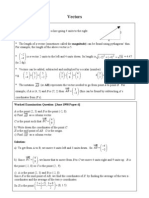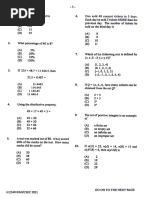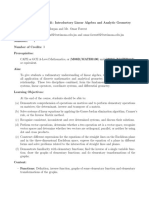Matrices - Lessons - Part 4
Matrices - Lessons - Part 4
Uploaded by
Anthony BensonCopyright:
Available Formats
Matrices - Lessons - Part 4
Matrices - Lessons - Part 4
Uploaded by
Anthony BensonCopyright
Available Formats
Share this document
Did you find this document useful?
Is this content inappropriate?
Copyright:
Available Formats
Matrices - Lessons - Part 4
Matrices - Lessons - Part 4
Uploaded by
Anthony BensonCopyright:
Available Formats
CXC Mathematics General Proficiency Matrices I & transformations I
Solving simultaneous equations using matrices
( )
¿a ¿b
If A = ¿ ¿
c d 2 ×2
then the determinant of A = a × d−b × c .
Examples:
( )
¿ 2 ¿1
1. If B = ¿ ¿ , then find the determinant of B
3 5
Solution:
determinant of B = a × d−b × c
= 2 ×5−1× 3
= 10 3
= 7 ans.
HW
2. Find the inverse of:
(a) (13 12)
(b) ( 04 20 )
(c) (69 32 )
(d) (−26 −4
0 )
(e) (13 −1
3 )
Revision notes Page | 1
CXC Mathematics General Proficiency Matrices I & transformations I
3. Calulate the value of x for which the determinant is 5.
( )
¿5 ¿2
¿ ¿
2 x−1 x
Solution:
determinant = 5
a × d−b × c = 5
5 x−2 ( 2 x−1 ) = 5
5 x−4 x+2 = 5
5 x−4 x = 5 2
x = 3 ans.
Note:
If the determinant of a matrix is 0 then the matrix has no inverse. It is called a singular matrix.
Questions: HW
1. N is the singular matrix ( 46 2k ). Find the value of k.
2. Determine the value of g given that M is the singular matrix ( 2p 48 ).
3. M is the matrix (−10
−4 x
−5 )
. Calculate the value of x which would make M a singular matrix.
4. If (m−1
5
2)
4
is a singular matrix, calculate the value of m.
5. M is the matrix ( 3p 4q). If M is a singular matrix and p = 2, calculate the value of q.
Revision notes Page | 2
CXC Mathematics General Proficiency Matrices I & transformations I
The inverse of a 2 by 2 matrix
If A = ( ac db ), then A 1 =
1
(
× d −b .
a ×d −b ×c −c a )
A 1 is the symbol for the inverse of the matrix A.
Note:
When a matrix has no inverse, then it is called a singular matrix.
If the determinant of a matrix is 0 then the matrix has no inverse.
Given that A = (31 62), then determinant = 3 × 2 – 6 × 1 = 0 .
The matrix A does not have an inverse, because the determinant is equal to zero.
This type of matrix is known as singular matrix.
A × A1 = 1
Examples:
1. Given that P = (75 86), find the inverse of the matrix P.
Solution:
Step 1: Calculate the determinant:
Step 2: Finding the adjoint:
Step 3: Substituting in the formula:
Revision notes Page | 3
CXC Mathematics General Proficiency Matrices I & transformations I
( )
3 −4
P -1
= −5 −7 ans.
2 2
2. Given that M = [52 155 ]
(a) Show that M is a non-singular matrix.
(b) Write down the inverse of M.
(c) Write down the 2 2 matrix which is equal to the product of M × M −1.
Revision notes Page | 4
CXC Mathematics General Proficiency Matrices I & transformations I
Using a problem using the method of matrices
Example:
A store sells large and small sizes of blue shirts and yellow shirts. The selling price of either shirt is $x for
a large size and $y for a small size. The table shows the number of shirts sold in a day.
large small
blue shirt 5 3
yellow shirt 6 4
The total income from the sale of the blue shirt was $84 and from the yellow shirt was $104.
1. Given that A = (56 34 ), B = ( xy ) and C = (104
84
),
(a) write down an equation connecting A, B and C
(b) find A-1
(c) calculate A -1C
(d) Explain the significance of your answer to part (c)
Solution:
1. (a) A×B = C
(b) Step 1: Calculate determinant: a × d−b × c
Determinant = 5 × 4 – 3 × 6
=2
Step 2: Determine the inverse:
1
(
× d −b .
a ×d −b ×c −c a )
Revision notes Page | 5
CXC Mathematics General Proficiency Matrices I & transformations I
(c) (
2 −1.5 84
A−1 C = −3 2.5 104 )( )
= ( )
12
8
(d) The answers in part (c) are the answers for the matrix B.
The cost of large size shirt (x) = $12 and the cost of small size shirt (y) = $8
Revision notes Page | 6
You might also like
- I. N. Herstein, David J. Winter - Matrix Theory and Linear Algebra (1988, Macmillan Pub Co) PDFDocument527 pagesI. N. Herstein, David J. Winter - Matrix Theory and Linear Algebra (1988, Macmillan Pub Co) PDFYEISON ARLEY HENAO CASTRILLON33% (3)
- CSEC® Mathematics Past Papers (Statistics)Document10 pagesCSEC® Mathematics Past Papers (Statistics)Anthony Benson100% (1)
- FE Exam Review Practice MO S&TDocument195 pagesFE Exam Review Practice MO S&TAkhdamli Services100% (1)
- Matrices Notes by TrockersDocument48 pagesMatrices Notes by TrockersMichael MyamboNo ratings yet
- CSEC TRANSFORMATIONS NotesDocument6 pagesCSEC TRANSFORMATIONS NotesDwayne DixonNo ratings yet
- CSEC® Mathematics Past Papers (Paper 2)Document20 pagesCSEC® Mathematics Past Papers (Paper 2)Anthony Benson100% (1)
- Number Theory & ComputationDocument66 pagesNumber Theory & ComputationShannon Smith100% (1)
- Machines Physics CXCDocument5 pagesMachines Physics CXCdemetri lanezNo ratings yet
- Sample For Solution Manual A First Course in Fuzzy and Neural Control by Nguyen & PrasadDocument7 pagesSample For Solution Manual A First Course in Fuzzy and Neural Control by Nguyen & Prasadomar burakNo ratings yet
- Transformations - SPQDocument10 pagesTransformations - SPQAnthony BensonNo ratings yet
- Graphs and Variations IDocument34 pagesGraphs and Variations IA.BensonNo ratings yet
- Statistics & ProbabilityDocument105 pagesStatistics & ProbabilityWilliNo ratings yet
- Cumulative Frequency - ConciseDocument20 pagesCumulative Frequency - ConciseBurhan AzharNo ratings yet
- CSEC Maths Geometry & TrignometryDocument10 pagesCSEC Maths Geometry & TrignometryDwayne DixonNo ratings yet
- Csec MathDocument9 pagesCsec MathCassidy Lozano100% (1)
- Worked Examples:: Consumer ArithmeticDocument3 pagesWorked Examples:: Consumer ArithmeticA.BensonNo ratings yet
- Past Paper Worksheet - Ratios and ProportionsDocument3 pagesPast Paper Worksheet - Ratios and ProportionsShenelle McleodNo ratings yet
- Some CXC Math MC Questions PDFDocument17 pagesSome CXC Math MC Questions PDFnaseeb100% (1)
- Mathematics CXC NotesDocument1 pageMathematics CXC NotesElisha ThomasNo ratings yet
- Sets - SPQDocument10 pagesSets - SPQAnthony BensonNo ratings yet
- VectorsDocument5 pagesVectorsZahid RajaNo ratings yet
- Relations and Functions - SPQDocument7 pagesRelations and Functions - SPQAnthony BensonNo ratings yet
- Matrices - PART 1 Form 5Document26 pagesMatrices - PART 1 Form 5Indar SoochitNo ratings yet
- Class 11 - Past Paper Revision SessionDocument38 pagesClass 11 - Past Paper Revision SessionJada Brown100% (1)
- Number Theory: Sets of NumbersDocument2 pagesNumber Theory: Sets of NumbersmelissaNo ratings yet
- Mathematics January 2020 Paper 2Document34 pagesMathematics January 2020 Paper 2Tamera Green100% (1)
- CSEC MATHEMATICS Assignment 1Document2 pagesCSEC MATHEMATICS Assignment 1Keri-ann MillarNo ratings yet
- Worksheet - MatricesDocument12 pagesWorksheet - MatricesChadymon EllisNo ratings yet
- CSEC Statistics Brief NotesDocument5 pagesCSEC Statistics Brief NotesJosane WilliamsNo ratings yet
- Linear Programming Jan 2017Document4 pagesLinear Programming Jan 2017melissa100% (1)
- Linear ProgrammingDocument5 pagesLinear ProgrammingMichael HarrichandsinghNo ratings yet
- Maths June 2021 P1Document13 pagesMaths June 2021 P1courtneiNo ratings yet
- CSEC Mathematics June 2004 P2Document15 pagesCSEC Mathematics June 2004 P2zarzsultan12100% (2)
- Fourth Form Mathematics Module 5Document85 pagesFourth Form Mathematics Module 5Chet Ack100% (1)
- CSEC Math Geometry - AnglesDocument11 pagesCSEC Math Geometry - Anglesg100% (1)
- CSEC MATHS - Mock Exam 2020 2 NEW SYLLABUSDocument11 pagesCSEC MATHS - Mock Exam 2020 2 NEW SYLLABUSRonaldo RambarranNo ratings yet
- Sba GuidelinesDocument2 pagesSba GuidelinesBrianna BaileyNo ratings yet
- CSEC Topics For MathsDocument1 pageCSEC Topics For Mathsnadine marchandNo ratings yet
- Class Work 1 - September 4, 2017Document2 pagesClass Work 1 - September 4, 2017Keri-ann MillarNo ratings yet
- Matrices CSEC QuestionsDocument8 pagesMatrices CSEC QuestionscoleykwesiannNo ratings yet
- CSEC Factorisation22Document4 pagesCSEC Factorisation22Daheima DavisNo ratings yet
- SBA Mark AllocationDocument2 pagesSBA Mark AllocationKeri-ann MillarNo ratings yet
- CSEC 06-UpDocument132 pagesCSEC 06-UpA.Benson100% (1)
- CSEC Mathematics SBA Guideline - MR Conlloyd GumbsDocument8 pagesCSEC Mathematics SBA Guideline - MR Conlloyd GumbsLyshii BooNo ratings yet
- CSEC Physics ManualDocument132 pagesCSEC Physics ManualHeythere HiNo ratings yet
- Matrix Operations and EquationsDocument1 pageMatrix Operations and EquationsRosemary ReynoldsNo ratings yet
- Worksheet 4Document4 pagesWorksheet 4JabarrioMykaelHolligan0% (2)
- Statistics WorkbookDocument27 pagesStatistics WorkbookTrudy-ann Smith100% (1)
- Toolsie 2Document925 pagesToolsie 2Dhatri Maharaj50% (2)
- Grade 8 Significant Figures Lesson 8Document2 pagesGrade 8 Significant Figures Lesson 8Kara NewmanNo ratings yet
- (Template) CXC Questions On FunctionsDocument2 pages(Template) CXC Questions On FunctionsAshleigh JarrettNo ratings yet
- Combined 2016 Ee PaperDocument30 pagesCombined 2016 Ee Paperolvernejacobs9741No ratings yet
- Physics CSEC Quizlet NotesDocument9 pagesPhysics CSEC Quizlet NotesTravis Dass100% (1)
- StatisticsDocument28 pagesStatisticsAnthony BensonNo ratings yet
- CSEC Social Studies January 2008 P2Document6 pagesCSEC Social Studies January 2008 P2nam tiddiesNo ratings yet
- Vectors and MatricesDocument102 pagesVectors and Matricespriya persaud100% (1)
- 2021 Jan CSEC Math Paper2Document34 pages2021 Jan CSEC Math Paper2Marie HenryNo ratings yet
- Direct and Inverse VariationDocument13 pagesDirect and Inverse VariationMrUnknownYTNo ratings yet
- Laws of IndicesDocument6 pagesLaws of IndicestrnsformerNo ratings yet
- C XCC Sec Maths Must Know ListDocument1 pageC XCC Sec Maths Must Know ListSwayne James100% (1)
- Curved GraphsDocument5 pagesCurved GraphsboostoberoiNo ratings yet
- CSEC BOOK LIST St. Stephens CollegeDocument5 pagesCSEC BOOK LIST St. Stephens CollegeNorma BarriosNo ratings yet
- Chapter 10: Trigonometry and Geometry IIDocument12 pagesChapter 10: Trigonometry and Geometry IIAnthony Benson100% (1)
- Sba Math Topics Csec 2022-23Document3 pagesSba Math Topics Csec 2022-23Heythere HiNo ratings yet
- Jamaica Driver's Education Handbook: A Comprehensive Driver Training GuideFrom EverandJamaica Driver's Education Handbook: A Comprehensive Driver Training GuideNo ratings yet
- Recitation Math 001 - Term 221 (26166)Document36 pagesRecitation Math 001 - Term 221 (26166)Ma NaNo ratings yet
- Photoshop Text Effects From ScratchDocument26 pagesPhotoshop Text Effects From ScratchAnthony BensonNo ratings yet
- Lesson Plan Grade 10 2017-2018Document21 pagesLesson Plan Grade 10 2017-2018Anthony BensonNo ratings yet
- Section # 4 A (RELATIONS, FUNCTIONS, GRAPHS I)Document15 pagesSection # 4 A (RELATIONS, FUNCTIONS, GRAPHS I)Anthony BensonNo ratings yet
- AcknowledgementDocument1 pageAcknowledgementAnthony BensonNo ratings yet
- Social Studies SbaDocument10 pagesSocial Studies SbaAnthony BensonNo ratings yet
- Add Visual Texture 3 Easy StepsDocument1 pageAdd Visual Texture 3 Easy StepsAnthony BensonNo ratings yet
- Cape Physics OTHER ISLANDS June Paper 2 (2008)Document12 pagesCape Physics OTHER ISLANDS June Paper 2 (2008)Anthony BensonNo ratings yet
- CSEC Mathematics - EvaluationDocument5 pagesCSEC Mathematics - EvaluationAnthony BensonNo ratings yet
- AbstractDocument2 pagesAbstractAnthony BensonNo ratings yet
- Sets - SPQDocument10 pagesSets - SPQAnthony BensonNo ratings yet
- Matrices - Lessons - Part 5Document7 pagesMatrices - Lessons - Part 5Anthony BensonNo ratings yet
- Construction: Geometric Construction Involves Drawing Shapes That Satisfy Certain RequirementsDocument30 pagesConstruction: Geometric Construction Involves Drawing Shapes That Satisfy Certain RequirementsAnthony BensonNo ratings yet
- Chapter 10: Trigonometry and Geometry IIDocument12 pagesChapter 10: Trigonometry and Geometry IIAnthony Benson100% (1)
- Relations and Functions - SPQDocument7 pagesRelations and Functions - SPQAnthony BensonNo ratings yet
- CSEC Mathematics - Graphs - (2015-2010)Document12 pagesCSEC Mathematics - Graphs - (2015-2010)Anthony BensonNo ratings yet
- CSEC Mathematics - Algebra - P2 - (2015-2010)Document15 pagesCSEC Mathematics - Algebra - P2 - (2015-2010)Anthony BensonNo ratings yet
- CSEC® Mathematics Past Papers (Paper 2)Document4 pagesCSEC® Mathematics Past Papers (Paper 2)Anthony BensonNo ratings yet
- Graphs and Variations IDocument16 pagesGraphs and Variations IAnthony BensonNo ratings yet
- Vectors - Lessons - Part ADocument14 pagesVectors - Lessons - Part AAnthony Benson100% (1)
- Relations, Functions and Graphs - WorksheetDocument5 pagesRelations, Functions and Graphs - WorksheetAnthony BensonNo ratings yet
- 5th Form Class Assignments: Transposition ElectrostaticsDocument2 pages5th Form Class Assignments: Transposition ElectrostaticsAnthony BensonNo ratings yet
- IntroductionDocument1 pageIntroductionAnthony BensonNo ratings yet
- Trigonometry II and Circle TheoremDocument27 pagesTrigonometry II and Circle TheoremAnthony BensonNo ratings yet
- Coordinate Geometry, Relations, Functions, Graphs and VariationsDocument30 pagesCoordinate Geometry, Relations, Functions, Graphs and VariationsAnthony BensonNo ratings yet
- StatisticsDocument28 pagesStatisticsAnthony BensonNo ratings yet
- Information ProcessingDocument10 pagesInformation ProcessingAnthony BensonNo ratings yet
- 3.b MeasurementsDocument23 pages3.b MeasurementsAnthony Benson100% (1)
- Dda Prospectus 2019 2020 2 PDFDocument29 pagesDda Prospectus 2019 2020 2 PDFAshutosh KumarNo ratings yet
- Simbol Matematik 2Document12 pagesSimbol Matematik 2Anonymous Ztyzc5No ratings yet
- A Refined Version of The Siegel-Shidlovskii Theorem: F (Z) A K! ZDocument11 pagesA Refined Version of The Siegel-Shidlovskii Theorem: F (Z) A K! Zferney10No ratings yet
- Matrix and DeterminantsDocument53 pagesMatrix and Determinantsarunesh shrivastavaNo ratings yet
- Lectures in Math 111: Linear Algebra Lecture 1. The Inverse of A MatrixDocument51 pagesLectures in Math 111: Linear Algebra Lecture 1. The Inverse of A MatrixAlexis AguillonNo ratings yet
- Appendix Matrix Introduction: A.1 BasicsDocument10 pagesAppendix Matrix Introduction: A.1 BasicsaprilswapnilNo ratings yet
- FB Applied Maths Module V5Document349 pagesFB Applied Maths Module V5reqiqie reqeqeNo ratings yet
- (Kurosh) Higher Algebra - Mir PublisherDocument433 pages(Kurosh) Higher Algebra - Mir PublisherSurabharathi Devabhasha100% (1)
- OutlineDocument2 pagesOutlineJavian CampbellNo ratings yet
- Mit18 06scf11 Ses2.5solDocument3 pagesMit18 06scf11 Ses2.5solSarthi GNo ratings yet
- Exercise 11A: TextbookDocument48 pagesExercise 11A: Textbook2C 29黃嘉朗No ratings yet
- Course NotesDocument218 pagesCourse NotesrdcfhNo ratings yet
- Discovering The Laplace TransformDocument18 pagesDiscovering The Laplace TransformAmir IqbalNo ratings yet
- REVIEWERDocument28 pagesREVIEWERjeniferNo ratings yet
- Full Download Elementary Linear Algebra with Applications MATLAB Mathematica and Maplesoft 1st Edition George Nakos PDF DOCXDocument81 pagesFull Download Elementary Linear Algebra with Applications MATLAB Mathematica and Maplesoft 1st Edition George Nakos PDF DOCXbchikharyaNo ratings yet
- Linear Algebra Matrices, Vectors, Determinants. Linear SystemsDocument53 pagesLinear Algebra Matrices, Vectors, Determinants. Linear SystemsHaroldNo ratings yet
- Aau Course Outline Introduction To Linear AlgebraDocument2 pagesAau Course Outline Introduction To Linear Algebralibanosyackob196100% (1)
- Tensor Analysis: Heinz Schade, Klaus NeemannDocument344 pagesTensor Analysis: Heinz Schade, Klaus NeemannMirok ZhangNo ratings yet
- 311 Maths Eng Lesson22Document30 pages311 Maths Eng Lesson22Shija. SpNo ratings yet
- Assignment Matrices and DeterminantsDocument4 pagesAssignment Matrices and DeterminantsJashan Jot SinghNo ratings yet
- Without Workbook PDFDocument51 pagesWithout Workbook PDFAnirudh KrishanaNo ratings yet
- Introduction To Tensor CalculusDocument34 pagesIntroduction To Tensor CalculusAbe100% (1)
- 5 6262661319476904563Document14 pages5 6262661319476904563krishnachaitanya kukunuriNo ratings yet
- JEE Main Chapter Wise Weightage Maths 2023 2019Document5 pagesJEE Main Chapter Wise Weightage Maths 2023 2019YasolakshmisriNo ratings yet
- MTH102 Linear AlgebraDocument15 pagesMTH102 Linear AlgebraEisa MohdNo ratings yet

















































































































